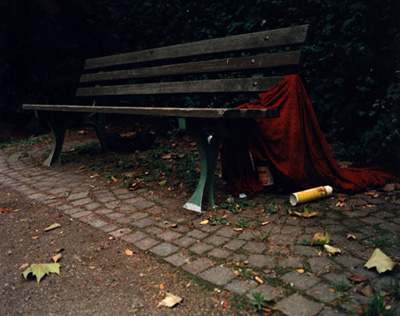Running Well: “Road Work”
S. E. Szucs presents three bodies of work--"Deer Project," "Recent Invitations to Religion," and "Fort Centennial" --in the show "Road Work" at the Tweed Museum in Duluth. It's a revelatory experience. January 21 - March 23.



In this ambitious show, “Roadwork: Three Photographic Projects from Home and Abroad,” Suzanne Szucs presents three very different bodies of work. I’ll look at them separately, but it’s important to say initially that they share a sensibility that is intensely engaged with subject-—with each separate set of subjects. This is not photography that is meant to express some thing about the photographer.
Rather, it’s work that is so in love with the world that the artist’s self seems present only as a necessary afterthought, a camera-holder. Of course this is never true, and is especially false here, where each body of work is presented differently; where each image is carefully and exquisitely printed. Obviously someone is doing this work, establishing these contexts, taking this care; obviously this work is created and presented by a distinct individual. But in the middle of the room, surrounded by the images, you notice only the world tumbling toward you, charged with its own various and insistent nature(s). What does this world look like, what does it contain?
As I mentioned, there are three bodies of work here. “Deer Project,” a group of large (37” x 47”) digital inkjet prints on canvas, depicts roadkilled deer Szucs found along the highways in Minnesota and Wisconsin. Dazzlingly white and blue, these snowy, sunny landscapes fringed with brush and trees are very familiar, dryly radiant. Angular and elegant corpses, golden with dashes of red and black, lie at the centers of these pictures. The brilliant sunlight in these images does give them an uncompromising force as well as beauty. The sun makes all plain. Szucs writes of these images as attempts to record the literal collision of the deer-world with the world of humans: their routes, our speed, our vehicles. Things cost.
The deer’s colors harmonize so closely with the colors of forest and snow that their corpses do not shock, except in the images where red appears. In one image (53 South, Wisconsin, Hwy 2 Turnoff, #1) you can see marks in the snow where the body was dragged from the highway; this also jars one into recognizing the violence of the event. The visual quietness and large scale of the images seem well chosen. They do not insist on judgment. They are records of certain events, now over, whose results speak for themselves in a rhetoric that does not manipulate the viewer.
“Recent Invitations to Religion,” on the other hand, is full of images that are not quiet or reposeful. They stream into the room. Printed as chromogenic prints and mounted behind plexiglas, these images’ colors are deeply saturated and shining. The images are from travels in Europe, and all record some seam, some odd mark left behind, some residue of presence. In the very old cities depicted in these images, some traces are ancient (the foot of a pillar, a collapsing masonry structure, and iron gate) and some are very recent (a juice bottle, spray can, and red shirt left by the last sleeper on a park bench). Each acts as a nail, a pin, that fixes an instant for a viewer’s gaze. The images are unframed, clipped directly onto the wall, and have a startling, almost violent effect: the eccentrically placed focal points hand that instant right out of the plane of the image into one’s very grasp. This effect cannot be duplicated in reproduction. The transparency and lucency of the images as they are presented in the gallery are very different from what you can see on this screen, for instance. Each image—the Pompeian dog, the stone hand reaching backward out to the viewer, the park bench dewy with recent presence, all the others—impresses itself on memory. This part of the show is breathtaking.
“Fort Centennial” is a documentary suite of photos that record the coastal defense architecture of an old fort in Port Townsend, Washington. These are digital inkjet prints on watercolor paper, floated in plywood frames, small-scale (10.5” x 14”). A unified palette of greens and greys with touches of yellow creates a distinct world; the matte surface of the prints is a distancing force, creating a tangible atmosphere around the images. It’s a past world, a ruin, being eaten, though slowly, by the stubborn weeds and trees of the coastal forest. Echoes of past fallen empires (those Mayan pillars! Memories of Hitler’s empty bunkers from Life magazine . . .) are inflected by a focus on the the insistent plants that burst through the concrete. It’s a timely meditation on the grandeur, pathos, and waste of military constructions, though not as powerful a group of works as the first two in the show, the deer and the urban traces.
Szucs clearly has a lot of range, both as a photographer and as a maker of photographic artifacts. These bodies of work have very different physical and emotional modalities. They share, though, an ability to see for the sake of the seen, not for the sake of the seer (this is fairly rare, in my experience, and valuable). I am haunted by some of these images; I’m willing to bet others will be as well.